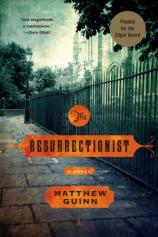The Resurrectionist
Review
The Resurrectionist
As Matthew Guinn hastens to inform us before his fine debut novel gets underway, a “resurrectionist” is a body snatcher, or grave robber. The term is used by Guinn in the literal sense and as a metaphor as well, as the actions of the past suddenly "rise up" and impact upon the present with unexpected and fascinating results.
THE RESURRECTIONIST is told in alternating narratives along two tracks. The first concerns the present and relates the story of Dr. Jacob Thacker, who is on probationary status due to Xanax abuse. Thacker has been relegated to a public relations position that involves, among other things, catching flak for the dean of the South Carolina Medical College. Thacker’s job suddenly becomes more interesting, and not in a good way, when a construction project on the campus unearths some old bones that threaten to expose a sordid period of the medical school’s history.
"While there are some explosive moments here, Guinn’s prose and pace are carefully measured. The parallels he draws between past and present events demonstrate that the most powerful person in the room isn’t always the most clever, and the promises of comeuppance that is made in both story tracks are fulfilled in different and unexpected ways."
The second track, which deals with the period stretching roughly from 1857 to 1866, tells the story of the early years of the medical school and Dr. Frederick Augustus Johnston, one of its founders. Johnston’s primary issues concern obtaining the requisite financing to keep the day-to-day operations afloat, and ensuring that the school is well-stocked with cadavers for the medical students to study and utilize for surgical practice.
Johnston’s solution to the latter problem is to purchase a slave for the purpose of procuring the bodies --- primarily people of color --- of the recently deceased. So he selects a man who takes the name of “Nemo,” meaning “no man,” in part because of his skill with a sharp blade and knowledge of anatomy. Nemo soon finds himself in the unique position of being a slave who is a de facto professor of surgery at the medical college by day and a resurrectionist by night.
As the separate storylines advance, Guinn draws some interesting and subtle comparisons between Thacker and Nemo, two men who are very different in many ways yet possessed of a rough integrity that constitutes a liability in their situations. Both find themselves used and abused by superiors and are, at least on the surface, unable to do anything about their situations. Yet, by story’s end, both are able to gain a measure of revenge, with Nemo indirectly aiding Thacker in his, though Nemo is over a century removed.
While there are some explosive moments here, Guinn’s prose and pace are carefully measured. The parallels he draws between past and present events demonstrate that the most powerful person in the room isn’t always the most clever, and the promises of comeuppance that is made in both story tracks are fulfilled in different and unexpected ways. Those of us who are untutored in the ways of medical education as practiced in the 19th century will find surprises aplenty, particularly with respect to admission requirements into those now-august institutions.
Guinn’s Historical Note at the conclusion of THE RESURRECTIONIST makes for brief but riveting reading, either before or after one begins the novel. Regardless, this is a noteworthy debut of an author from whom we will hopefully read more, and soon.
Reviewed by Joe Hartlaub on July 19, 2013
The Resurrectionist
- Publication Date: August 4, 2014
- Genres: Fiction
- Paperback: 304 pages
- Publisher: W. W. Norton & Company
- ISBN-10: 0393348814
- ISBN-13: 9780393348811





